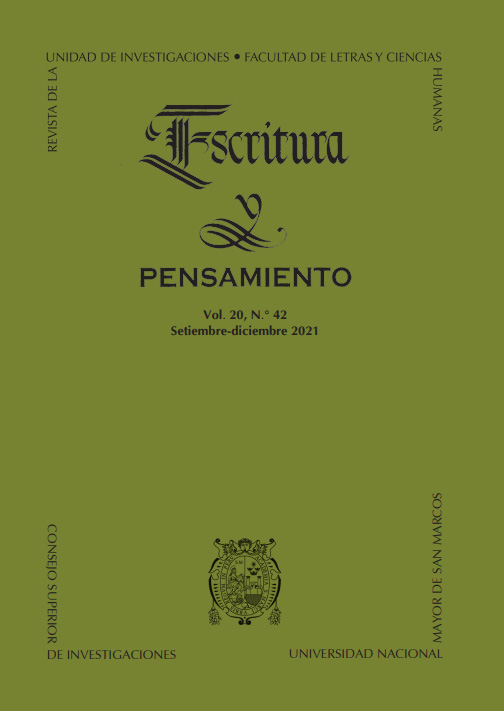An approach to the poetry of Alejandra Pizarnik: From the body to the symbols
DOI:
https://doi.org/10.15381/escrypensam.v20i42.21199Keywords:
body, psychoanalysis, symbology, literatureAbstract
In order to approach Alejandra Pizarnik's poetic corpus, from new perspectives that contribute to its better reading and interpretation, it is necessary to review certain relationships that are established between some variables of her work. In this article we propose a tripartite framework established by the body, psychoanalysis and symbology with the aim of establishing a line of approach to Alejandra Pizarnik's poetry, while we consider that this author embodies, throughout her work, a set of symbols that articulate his poetry and that characterize it particularly; symbols that keep a close correspondence between the female body and between some aspects addressed by psychoanalysis.
References
Chevalier, J. & Gheerbrant, A. (2012). Diccionario de los símbolos. Barcelona: Herder Editorial.
Chirinos, E. (1998). La Morada del silencio. Lima: Fondo de Cultura Económica.
Cirlot, J. (2011). Diccionario de símbolos. Barcelona: Siruela.
Le Breton, D. (2002). La sociología del cuerpo. Buenos Aires: Claves-Dominios.
López, M. (2010). Una simbología otra del cuerpo de la mujer: la apertura al otro. Investigaciones Fenomenológicas, vol. monográfico 2: Cuerpo y alteridad. Recuperado de: Jueves 12 de agosto de 2021, 22.12 horas.
Payne, M., (Comp.). (2002). Diccionario de teoría crítica y estudios culturales. Buenos Aires: Editorial Paidós.
Pizarnik, A. (2012). Poesía (1955-1972). Edición a cargo de Ana Becciú. Barcelona: Editorial Lumen.
Pizarnik, A. (2013). Diarios. Nueva edición de Ana Becciú. Barcelona: Editorial Lumen.
Rancière, J. (2009). La palabra muda. Ensayo sobre las contradicciones de la literatura. Buenos Aires: Tierna Cadencia Editora.
Downloads
Published
Issue
Section
License
Copyright (c) 2021 Luis Humberto Fuentes Rojas

This work is licensed under a Creative Commons Attribution 4.0 International License.
AUTHORS RETAIN THEIR RIGHTS:
a. The authors retain their trademark and patent rights, and also over any process or procedure described in the article.
b. The authors retain the right to share, copy, distribute, execute and publicly communicate the article published in the Escritura y Pensamiento (for example, place it in an institutional repository or publish as part a book), with acknowledgment of its initial publication by Escritura y Pensamiento.
c. Authors retain the right to make a subsequent publication of their work, to use the article or any part of it (for example: a compilation of their work, lecture notes, thesis, or for a book), provided that they indicate the source of publication (authors of the work, journal, volume, number and date).













